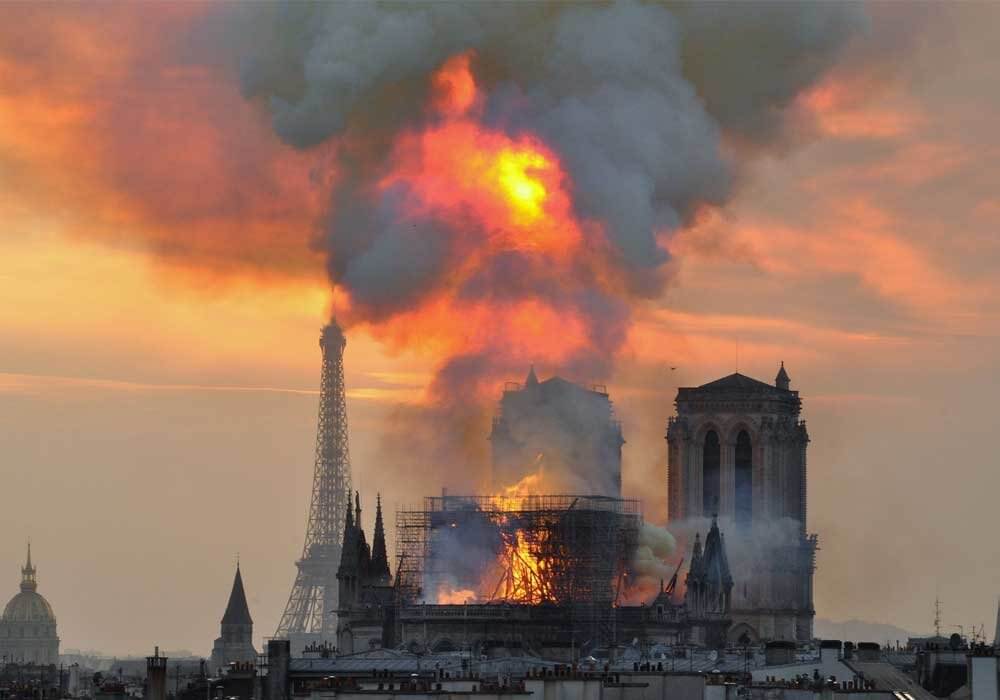
Notre-Dame: Fire in the spire
18.04.19The world wept on Monday as images of the legendary Notre-Dame cathedral set ablaze during its ongoing renovation were broadcast. The UNESCO World Heritage Site had stood proudly in Paris for over 850 years and is one of the finest examples of French Gothic architecture - but what now for the cathedral? Luke Thomas investigates
Notre-Dame cathedral is a beautiful, imposing marvel of human innovation. Standing for nearly 900 years, the grand old building is one of Paris’ proudest landmarks and a sought after locale by both Catholics and tourists alike.
The blaze earlier this week burned from around 18:20 to 23:10. Being aflame for the best part of five hours saw extensive damage to the cathedral, and led, in heart-breaking scenes, to the collapse of its iconic spire.
But what sort of state was the cathedral in before the fire? Why did it go up in flames? And is renovation for a victim of a fire of this magnitude possible?
What state was Notre-Dame in already?
In short, renovation was long overdue. With original construction starting in 1163, Notre Dame took over 200 years to complete, and since then, it’s been repeatedly looted and damaged by the likes of the Huguenots and during the French Revolution. Until the mid-1800s, the grand building was in such poor shape it was set to be demolished had Napoleon not insisted that his coronation be held there.
In 1831 Victor Hugo’s Hunchback of Notre Dame was published, and the cathedral experienced a resurgence of interest. The church underwent restoration from 1845-1870, and new buildings were added. Unfortunately, inferior materials were used during the project, which meant much of the original building was in better shape than the areas restored in the nineteenth century. The result left Paris with an already crumbling icon.
With no renovation works carried out for close to 200 years, architects and historians alike agreed that the cathedral was in desperate need of repairs. When the fire broke out, a $6.8 million project was already in progress to work on the church’s iconic spire. One of the cathedral’s famed gargoyles used to drain water, had fallen off the building and another one was disintegrating, resulting in the Archdiocese using plastic pipes instead.
The main reason for the poor state of Notre-Dame is thought to be pollution. A 2016 report from Forbes declared that Paris’ pollution was so bad city officials had made greater efforts to control traffic, including driving bans for private vehicles on alternate days determined by license plates.
The pollution in the city had severely damaged the cathedral. Philippe Villeneuve, architect in chief of historic monuments in France said in 2017 “Pollution is the biggest culprit. We need to replace the ruined stones. We need to replace the joints with traditional materials. This is going to be extensive.”
What caused the blaze? Why was it so severe?
It’s still not clear what caused the fire, but as comprehensive renovation works were being carried out, it’s thought they may be the root of the cause. Renovation can often cause fires, and it’s suspected that the Notre-Dame fire may have been caused by such work, which required blowtorch use. Repairs to the lead roof required welding lead sheets which rested on dry, well-seasoned timber, much of it porous or powdery with age. This is a particularly risky process for historic buildings.
Unfortunately, as with a lot of ancient buildings, Notre-Dame is somewhat of a tinder box. The attic, where the fire is thought to have originated, was made up of a combustible lattice of dry wood beams, and centuries of dust and debris may have made the area even more flammable.
When the first alarm went off at 18:20, no fire was found, and by the time a second alarm sounded 23 minutes later, the flames were already raging.
While Notre-Dame has a smoke detection system, it does not have other basic fire-safety measures, such as fire-resistant walls that could have divided the space and helped to contain the fire, or a sprinkler system. Other major cathedrals in Britain and France have been retrofitted with similar designs, but Notre-Dame was not.
The architecture of the cathedral made fighting the fire extremely difficult, which is evidenced by the amount of time it took to finally put out. The cathedral’s vaulted stone ceiling prevented firefighters from shooting water at the attic from the ground, which meant they may have had to wait until the fire burned through the lead panels on the roof before they could start to spray water from above.
Can Notre-Dame be restored to its former glory?
French President Macron has pledged that every effort will be made to restore the grand old cathedral, and architects agree that it can be done, although it is thought that it will take years and cost upwards of $1billion.
A global outpour of support has been pledged to renovating the cathedral, with over $800,000 already put aside by various businesses and organisations. A competition is also being run to find the ideal architect to redesign Notre-Dame’s glorious spire and roofline in time for the 2014 Olympics which are being held in Paris.
The fire may have been devastating, but Notre-Dame is not the first notable historical religious site to go up in flames in recent history. In 1984, York Minster suffered a serious fire in its south transept during the early morning during which the roof and its rose windows were destroyed.
Firefighters made a decision to deliberately collapse the roof by pouring tens of thousands of gallons of water onto it in order to save the rest of the building from destruction. A total of 114 firefighters from across North Yorkshire responded to the fire and contained it, while York Minster's staff and clergy rushed to preserve historical objects in the building. A subsequent investigation found an 80% chance that the fire was caused by a lightning strike to a metal electrical box atop the roof.
The fire caused £2.25m of damage to the Minister, and a restoration project took place in 1988. This was followed up by modern restorations starting in 2007 and finishing last year.
John David, a master mason at York Minster, believes that much like York Minister, Notre-Dame could be rebuilt using traditional crafts. Mr David, who was working at the Minster in 1984 and dealt with the reconstruction after that fire, said work to repair the building may take time, but it would be done properly.
."At York Minster there were questions about whether we put an oak roof back on top or a steel or even concrete roof.
"Some people think we can't do this sort of thing any more in traditional materials - we can, and so I think the roof will be reconstructed and put back on.
"I don't think it will take 10 years - it might take two years to decide what to do, but it's quite achievable."
"The upper stone work, the vaulting and the top windows, will have been baked and the temperature will have spoiled and weakened the stone," says Paul Binski, a history of medieval art professor at the University of Cambridge.
Experts agree that the whole building is going to have to be scaffolded as the stone ceiling will have taken the brunt of the impact when the timber roof above collapsed.
"It's important to look at the original construction methods and try to emulate them." Prof Binski explains. "This involves building an awful lot of wood scaffolding inside the church because stone vaulting is built around a kind of wooden structure - like a mould. They're not built with cement but with something that's rather like putty."
No matter the methods used, work will have to be completed in short order, as Macron has promised restoration completion in time for the 2024 Olympics.
In an address the day after the disaster he said: “We will rebuild the cathedral even more beautifully and I want it to be finished within five years.”
It remains to be seen if this ambitious pledge can be achieved.
Abode Affiliates
COPYRIGHT © Abode2 2012-2024





















































































































































































































